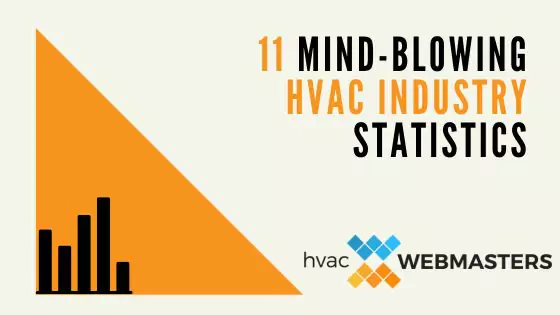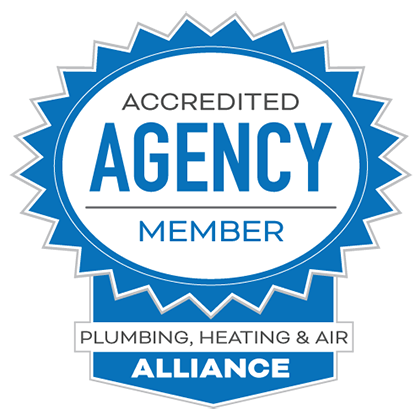Whether you are considering a career in HVAC or are already firmly entrenched in the industry, HVAC industry statistics are a valuable resource.
Some worry about the long-term viability of the HVAC industry, though most of the data paints a favorable picture of the future of this long-standing trade industry.
In the age of fear-mongering and misinformation, there is strength in numbers and statistical numbers in particular. The raw data removes inherent biases and delivers objective projections on the industry’s future.

The following article will outline 11 of the most compelling HVAC industry statistics for 2025.
Quick Statistics for the HVAC Industry
- The HVAC Market is Projected to Grow by 6.28%
- The Average HVAC Technician’s Salary is $27.21 Per Hour
- 70% of HVAC Companies Dislike Their SEO Provider
- 40,100 new HVAC Jobs will Be Created by 2033
- 75% of US Homes Have Central Air
- 67% of Southern Households Leave Their AC Running All Day
- The Average American Pays $293 for HVAC Repair
- Florida Has 37,370 HVAC Workers Statewide
- Over 70% of U.S Homes Have ACs installed
- 43% of U.S. Power Generation is From Gas
- Thermostats Last an Average of 10 Years
1) The HVAC Market is Projected to Grow by 6.28%
Today, the HVAC market is estimated to be worth 65.72 million. That number is projected to reach 89.11 billion dollars in just five years, representing an industry growth of 6.28%.
Beyond this immediate growth, experts predict that with the ongoing climate changes, demand for HVAC systems will only continue to grow. Such a trend may be particularly interesting if you try to decide on a career path with good job security.
Homeowners regularly invest in unit upgrades, creating a demand for heating and cooling jobs across the US and other countries.
2) The Average HVAC Technician Salary is $23.68 Per Hour in the US
So you know your HVAC job isn’t likely to be in danger any time soon, but how much can you expect to be paid? That all depends. Where you live is the number one factor determining your HVAC salary.
The average salary for HVAC technicians varies by state. The national average, however, is $27.21 per hour. To put that figure into perspective, consider that the national average for hourly pay in the US was $11.24.
To give you even more perspective, some of the highest-paying states for HVAC contractors and technicians are on the East Coast.
For example, Oregon pays its HVAC technicians the highest national hourly rate, $29.88. Conversely, Florida HVAC specialists earn the lowest average, just $21.12 per hour—more than five dollars below the national average.
3) 70% of HVAC Companies Dislike Their SEO Provider
According to industry research, including independent studies from HVAC Webmasters, roughly 7 out of 10 HVAC companies with digital marketing agencies are unsatisfied with the results.
Regarding SEO, it can be difficult to gauge performance properly, as traffic does not always equate to leads.
Several marketing companies lack billing transparency, causing clients to become unaware of what they are actually paying for.
In these cases, contractors might also be locked into 12-24-month agreements without an opt-out clause. These kinds of tactics are understandably frustrating.
Despite the overwhelming discontent with marketing services, nearly all successful HVAC companies are investing in marketing of some kind.
As a result, professionals broadly understand that while finding a competent HVAC SEO company is challenging, growing a business is necessary.
4) 40,100 new HVAC Jobs will Be Created by 2033
If you are wondering how likely it will be to find a job once you are a licensed HVAC technician, consider the following statistic: the Bureau of Labor estimates that by 2033, 40,100 more HVAC jobs will be created in the US alone.
What’s the reason for this boom? The growth of the construction industry is a primary culprit. The HVAC and construction industries have always been closely tied; as one goes, so does the other.
Labor experts believe the HVAC industry will also grow because the construction industry is projected to grow in the coming years. As a result, 40,100 more jobs will need to be filled by 2033, translating to a 9% increase in job growth.
5) 75% of US Homes Have Central Air
What might you want to specialize in as an HVAC contractor or technician? According to experts, you might want to brush up on central air units in particular.
It is estimated that 75% of US households have central air systems installed.
Regional climate plays a role in the number of households with central air. For example, if you live in a northern state, you will likely see fewer central air units.
In these regions, you may encounter window units and individual cooling appliances in colder regions where air conditioning is only needed for a few months a year.
In this case, it may be wiser to specialize in swamp coolers, window units, and portable AC systems.
6) 67% of Southern Households Leave Their AC Running All Day
A survey of Southern households revealed that more than 67% of residents leave their air conditioners running all day. This behavior can be attributed to the region’s warm climate and seasonal length.
Unfortunately, this trend doesn’t always correlate to more service jobs. Most people don’t have their air conditioner serviced yearly like they should—even in Southern states.
Still, this statistic is encouraging for an HVAC contractor because you know there will be many AC repair and replacement opportunities in the South.
7) The Average American Pays $293 for HVAC Repair
There are no set guidelines for how much someone will pay for HVAC repair/service.
It will always depend on location, the nature of the repair/maintenance, the type of unit, and the service provider, among other factors.
On average, you will pay $319 to repair or service your AC. If you need your furnace looked at, you can expect to pay an average of $268. You can also spend as much as $2,900 for serious HVAC repair jobs or installations.
Heating and cooling maintenance jobs are lucrative in many states. The demand for repairs and installations is relatively consistent, though seasonal dips are more pronounced in certain regions.
8) Florida Has The Most HVAC Jobs
The consistency of job availability depends on various factors, including weather conditions and seasonality. The states with the most HVAC jobs might be the two that you would naturally expect.
Florida employs 37,370 HVAC technicians and contractors, the highest number in the country. California has the highest number of HVAC employees, with 35,630.
Those numbers are expected to hold steady, too. As a result, the HVAC industry’s job growth is expected to mirror the overall industry growth in the nation.
9) Over 70% of U.S Homes Have ACs installed
The sheer percentage of U.S. homeowners with installed air conditioner units represents a favorable market projection for companies and technicians. The equipment will invariably require repairs, maintenance, and replacement.
As Grand View Research describes, original equipment manufacturers can anticipate a 20%-30% market opportunity for new unit sales and replacements due to aging air conditioners.
Due to their superior efficiency, electric water heaters waste less electricity and water. As a result, consumers can save money while reducing their carbon footprints.
10) More People Use Gas and Electricity to Heat their Homes
Homeowners recognize the benefits of electric heating and heat pumps, which offer excellent energy efficiency compared to gas or oil furnaces.
Heat pumps can heat and cool, allowing for a consolidation of cumbersome units.
Gone are the days of kerosene, propane, and fuel oil. Instead, most Americans use gas and electricity to heat their homes. It is estimated that 43% of power generation is from gas, while 44% have already switched to electrical heating systems.
Trends like these reflect energy usage shifts as consumers and regulators look toward cleaner grids.
Homeowners, in particular, are seeking electric energy solutions that benefit the environment while cutting their energy bills.
11) The Average U.S. Home’s Thermostat Lasts 10 Years
Smart thermostats provide several benefits, like remote control and smartphone compatibility. Most importantly, they feature AI-powered scheduling to optimize energy usage within homes.
As older models die out, we see more adoption of this technologically advanced alternative.
A thermostat inside an American home lasts an average of 10 years before requiring a replacement. Because of technological advancements and new product features, homeowners frequently replace their thermostats before the 10-year mark.
Utility companies will provide rebates and other incentives for energy-efficient thermostats, which increases the financial motivation to adopt these devices.
Take your HVAC Company Into the Future
Here at HVAC Webmasters, we are all about helping contractors prepare for sustained success. That’s why we wanted to provide some HVAC industry statistics highlighting current trends.
While the industry is not protected against rapid changes in technology and society, it is one of the most well-positioned to withstand and adapt to these alterations.
Our agency offers digital marketing services to help you embrace the new trends and remain an authority in your location and niche. Together, we can maximize your success going forward.





